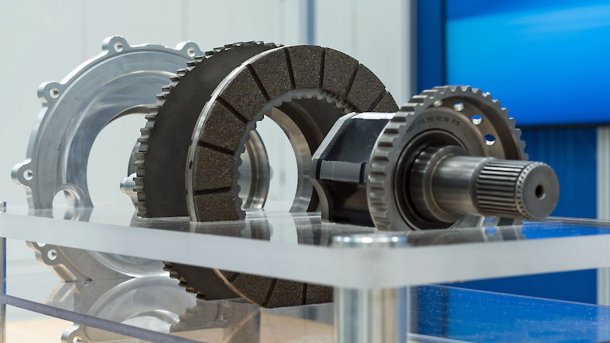Mercedes-Benz In-Drive Brake: free of fine dust, easy to drive and aerodynamic
With the In-Drive Brake, Mercedes-Benz shows that a brake system without particulate matter would also have advantages on aero- and driving dynamics.

Mercedes-Benz In-Drive Brake as a model
(Image: Mercedes-Benz)
The unstoppable spread of electromobility and new standards are leading to new requirements for car design elements, some of which have only been adapted in detail for decades. The electric car, for example, does not need a silencer and usually manages without a clutch. Mercedes is using the task of the upcoming emission standards to reduce particulate matter, as already laid out for the first time in Euro 7, to give fundamental thought to the braking system. However, the fact that the whole thing is now being demonstrated in the context of an electric car drive is not related to electrification. The whole thing could also be integrated into conventional automatic or manual transmissions. The only new aspect is how the individual design elements are brought together. In all aspects, the engineers at Mercedes-Benz are drawing on tried and tested design principles.
Familiar from the automatic transmission
Foremost, the design: Mercedes does not even try to reduce brake dust with new pad materials and brake disks or even suction systems, as proposed by Schaeffler. They use a principle that does not release any abrasion into the atmosphere and resort to a friction disk brake in an oil bath. This develops less abrasion due to its design alone. This is then absorbed by the oil and stored in a filter until the next inspection and oil change. Such units have long been familiar from automatic transmission construction, where they alternately brake the various gear sets to adjust the gear steps with their different ratios in the planetary gear sets.
Improved road grip
So that the brakes do not require their own oil circuit and housing, they are integrated into the transmission, right on the outside, directly in front of the outward-facing flanges for the drive shafts. This results in a decisive advantage in terms of driving dynamics. The braking force is transmitted via the drive shafts, and brakes directly on the wheels can be omitted. This considerably reduces the so-called unsprung masses and enables noticeably improved road grip. This is made more difficult by so-called wheel load fluctuations, which generate all the more violent forces the greater the unsprung mass is in relation to the sprung mass of the vehicle. These forces, which are generated by the elastic excitation of the suspension and tires, attempt to move the wheel away from the road and must be dissipated in the damping. To improve the ratio of unsprung to sprung mass, particularly light wheels and brake systems with lightweight components such as carbon fiber ceramic brake discs and aluminum brake calipers are usually used.
Mercedes-Benz In-Drive-Bremse (8 Bilder)

Mercedes-Benz
)Anyone wondering why this has not already been done with conventional brakes is overlooking the designs used by Audi, Alfa Romeo, Citroën, Jaguar and other manufacturers of cars known for their good road holding. The latter were still being built in this way until the 1990s, when even the last design departments were taken over by controllers. This time they meant business. Where costs could be saved, the engineers were squeezed to the limit. Originally, the brakes on the gearbox were a very noble takeover from Formula 1, where this principle was first successful on a broad front in the 1960s.
Aerodynamic advantage
And, please, anyone who was annoyed by the dark dust when cleaning the rims is twice as well off with such a brake: at last the designers can once again use closed disk wheels with their undeniable aerodynamic advantages because the large holes in the flanks no longer slow down the airflow. Such smooth rims are easier to service anyway.
It's all been done before – albeit in reverse
The question of where the heat goes when you have to tackle a pass road with a full load can be answered in two ways. Firstly, as you can see in the photos, the heat dissipated is extracted from the oil by an oil/water heat exchanger and released into the atmosphere via a water/air heat exchanger (aka radiator). Secondly, an electric car generally requires less frictional braking force because most of it can already be dissipated via recuperation.
In the unlikely event of a full battery into which recuperation is not possible, some high-load resistors would then have to dissipate the excess in the form of heat. This principle has also been tried and tested for a long time. Since the 1950s, large trucks have been equipped with electric motors (invented by Telma, also built by Kloft) to relieve the load on their service brakes. The so-called electrodynamic retarder is located at the end of the transmission on the cardan shaft to the drive axle and is activated on long downhill stretches to exert braking force on the cardan shaft and thus the rear wheels.
The whole thing is apparently still at the feasibility study stage and not yet close enough to series production for the manufacturer to name specific application targets. Nevertheless, the approach is exciting because it is visibly reality-based throughout. You could hear about it again.
More about the brand
For more range: Mercedes Benz researches "solar paint" for electric cars
eActros 600 series production: battery-powered truck with a range of 500 km
The next Mercedes CLA: electric car to charge very quickly
Mercedes and BMW: sales fall in the third quarter
Formula 1: The technology behind the Mercedes-AMG Petronas Team
(fpi)